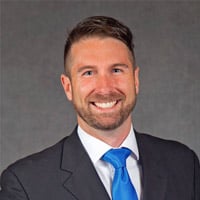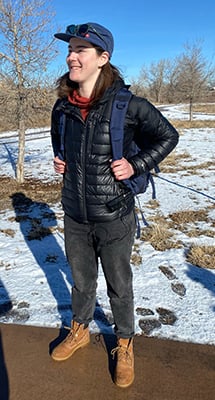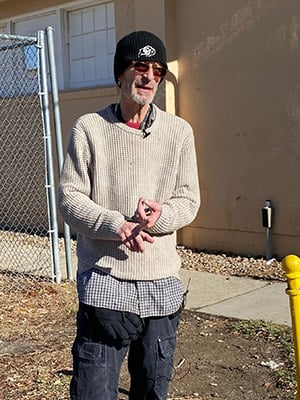On a cold January day, five volunteers bundled in heavy coats and boots stomped around the snow in a remote area of Aurora looking for people experiencing homelessness who may need medical care. The volunteers are part of a team called CU Street Medicine that makes old-fashioned house calls for “rough sleepers” wherever they are; in parks, under bridges, along trails, and on sidewalks.

Scott Harpin, PhD, MPH, RN, Associate Professor at the CU College of Nursing and co-chair of the CU Street Medicine program |
“The motto of the CU Street Medicine team is to bring care to the people,” said Scott Harpin, PhD, MPH, RN, Associate Professor at the University of Colorado College of Nursing and the co-chair of the CU Street Medicine program.
“We have to be unique and innovative in how we get models of care to people in our community because that one-size-fits-all model does not work for everyone. That’s what makes me proud of the street medicine program – that we try to bring health and wellness to the people.”
CU Street Medicine team was founded in early 2021 by a CU student group that connects healthcare students to external volunteer opportunities like YHC Clinic for street medicine. CU Medical student Rebecca Henkind and CU Nursing student (now alumni) Kiera Connelly met and became friends while working at the Colorado Coalition for the Homeless before attending CU. The women, both EMTs, wanted other healthcare students to experience working with an often ignored and disrespected population and, hopefully, transform perceptions.
“People experiencing homelessness have the most barriers to accessing healthcare. Even when they do access it, they experience a lot of negativity and trauma trying to navigate the system while being unhoused,” says Kiera Connelly, RN. “They are still human. But when healthcare professionals get burned out, the first thing to go is their compassion. It's tough to see. I think this program will help us provide better care because it teaches students not to make assumptions and to see the whole person.”

Kiera Connelly, RN (BSN '21) |
On that January day, the team met Guy Niederwerfer at the Aurora Day Resource Center. The 52-year-old Colorado native was experiencing his second bout of homelessness after losing his job at Amazon. He says getting medical care without transportation and other resources is challenging.
“When it comes to being homeless, it’s hard to find any kind of help. You’ve got to go through so many steps just to get food stamps and a bus pass. You feel frustrated and feel useless,” he said.
His statement echoes a common theme of other basic needs and what is called ‘social determinants of health’ impacting lives in all walks of life.
The street medicine team is an interprofessional organization comprised of students and faculty on the CU Anschutz Medical Campus and community partners including Connelly, Henkind, Dr. Harpin, and program co-chair Dr. Katy Boyd-Trull. They partner with community collaborators. On this day, it was Sarah Nachtman, the community well-being manager for the City of Commerce City, and her city council and police department. The group received support, guidance, and funding from the Street Medicine Institute and has been noted as an exemplar of community clinical care by the CU Anschutz chancellor.

Guy Niederwerfer - experiencing homelessness |
Twice a week, members of the team spend their own time finding and talking to homeless clients about their medical issues. They sit with people, listen to stories, then provide resources and treatment.
“We see a lot of common ailments like high blood pressure, high blood sugar, and a lot of wounds. I perform wound care, frostbite care, and try to address other medical issues,” said Connelly.
“We have a licensed medical provider on call, Dr. Boyd-Trull, whom we consult with. She can call in prescriptions. I can go pick them up and deliver them to the patients and teach them how to properly take the medication.”
The program is what Harpin calls a ‘win-win-win.’ Individuals receive care wherever they sleep, the university is able to offer a unique, impactful curriculum, and students often find a new passion for healthcare and learn about social justice in a way that can’t be taught in classrooms.
“This is one of the most powerful clinical experiences the students can have. They learn how to talk to and get to know folks and how to address their actual needs. The truth is, there is not a single definition for why people end up living on the streets. When the students do this volunteer work, they often fall in love with healthcare again. So, they don’t just find compassion for the people they’re working with, they also get back to the roots of why they applied to be in healthcare, to begin with,” said Dr. Harpin.
We spoke with members of CU Street Medicine about obstacles they face, including a rise in homelessness, substance abuse, and a lack of funding. All liability and malpractice coverage for students to volunteer comes from YHC which was founded by Dr. Katy Boyd-Trull, co-CU Street Med faculty advisor.

CU Street Medicine team |



